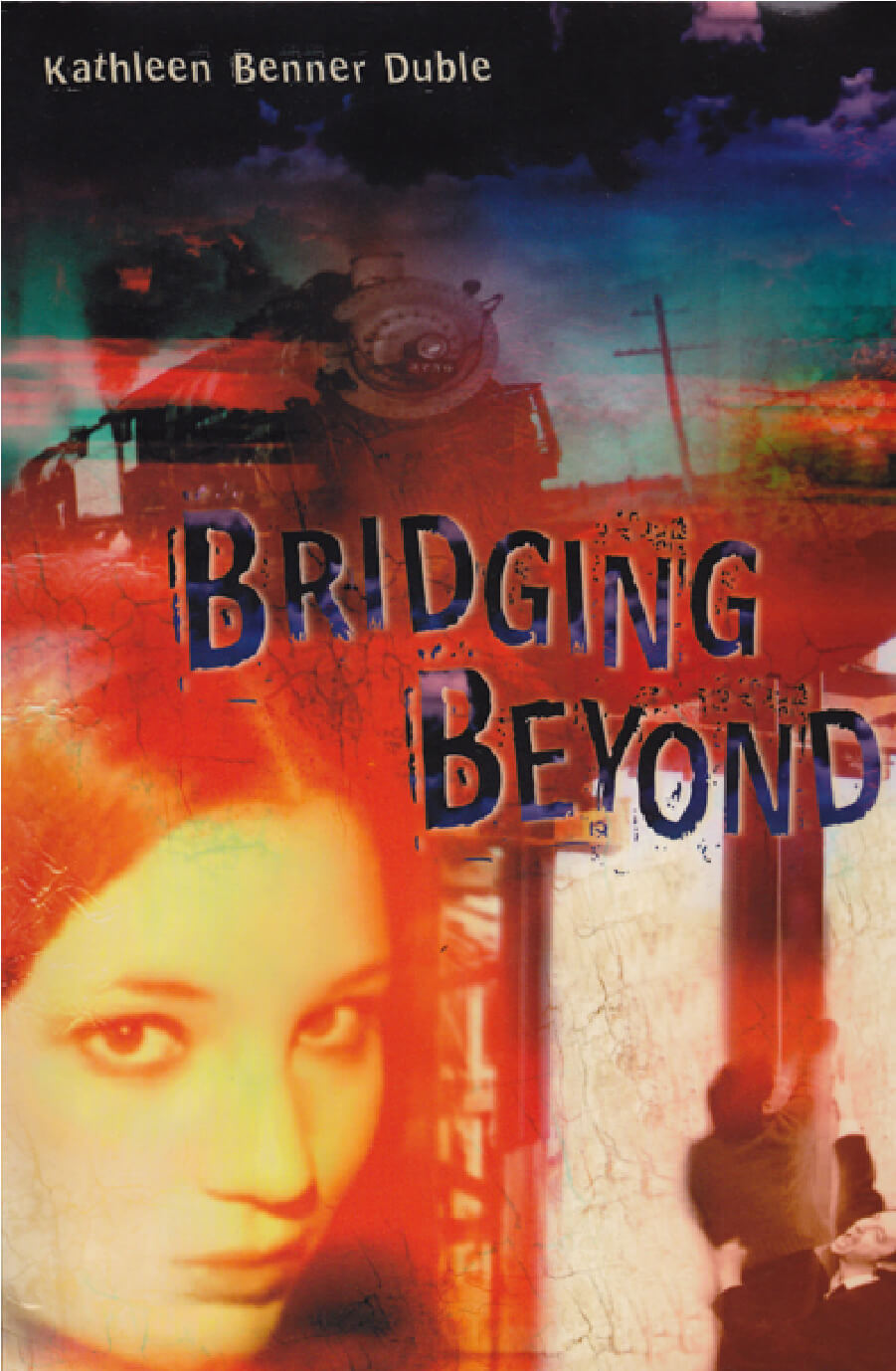

Bridging Beyond
Publisher: Philomel May 2002.
Age group: 12-17
Jacket illustration: Chris Nurse.
Genre: Magical Realism
ISBN 13: 978-0399236372
To buy this book
- Description
- Book Club Ideas
- Discussions
Description
The screams still haunt Anna. First, the driving rain. Then the train, emerging from the darkness like a monster in the night. She remembers the fear, and climbing onto the beam of the bridge. And she remembers falling …
Trouble is, that wasn’t Anna out there on that bridge. So who was it? And why has Anna been reliving her memories over and over, like a nightmare that never ends?
Kathleen Benner Duble’s suspenseful debut novel is a complex mystery that explores the layers of our minds, and the bridges that unite them. You may never look at your dreams the same way again.
2002 IRA Notable Honor Book
“An intriguing novel that could be read as science fiction or science theory, with the plot based on the main character experiencing the actual memories of her dead great-grandmother: Is it genetic memory? It’s a good story, in any case.”
– KLIATT.
“Utilizing the clever and imaginary psychological premise of ‘genetic memory’, first-time novelist Duble offers an eerie tale. This is a complex plot with a keen sense of both psychology and the variety of human social stigmata” – SL.
Book Club ideas
FOR BRIDGING BEYOND :
BRIDGING BEYOND BOOK IDEAS:
VENUE: As Bridging Beyond takes place during the roaring 1920’s, set up your own speakeasy. Have your book clubbers don flapper dresses and heels and headbands with feathers. Listen to a little jazz of the era, musicians like Duke Ellington. Or screen one of the movies I watched before writing Bridging Beyond: Thoroughly Modern Millie starring Julie Andrews.
FOOD: Whoopie pies were invented in the 1920’s. There is some argument over where they originated. Mainers claim Whoopie pies were first produced in their state by Labadie’s Bakery in Lewiston, ME in 1925. The Whoopie pie is now the official “treat” of the state of Maine. Others claim that the Amish invented the Whoopie Pie sometime in the 1920’s and were sold by the bakery Harris and Boyar. Supposedly, the Amish women would put these pies in their family’s lunches and when their family members saw them, they would shout “Whoopie!” Whether this is true or not, Whoopie pies are fun to make and better to eat. Here is an easy recipe for your book clubbers to try:
Ingredients
Cookie Dough:
- 2 cup(s) all-purpose flour
- 1 cup(s) sugar
- 3/4 cup(s) milk
- 1/2 cup(s) unsweetened cocoa
- 6 tablespoon(s) butter or margarine, melted
- 1 teaspoon(s) baking soda
- 1 teaspoon(s) vanilla extract
- 1/4 teaspoon(s) salt
- 1 large egg
Marshmallow Cream Filling:
- 6 tablespoon(s) butter or margarine, slightly softened
- 1 cup(s) confectioners’ sugar
- 1 jar(s) (7- to 7 1/2-ounce) marshmallow cream
- 1 teaspoon(s) vanilla extract
Directions
- Preheat oven to 350 degrees F. Grease 2 large cookie sheets.
- Prepare Cookie Dough: In large bowl, with spoon, mix all dough ingredients until smooth.
- Drop dough by heaping tablespoons, 2 inches apart, on each prepared cookie sheet. (There will be 12 rounds per sheet.)
- Bake 12 to 14 minutes, rotating sheets between upper and lower racks halfway through baking, until puffy and toothpick inserted in center comes out clean. With wide spatula, transfer cookies to wire racks to cool completely.
- Prepare Marshmallow Cream Filling: In large bowl, with mixer at medium speed, beat butter until smooth. Reduce speed to low; gradually beat in confectioners’ sugar. Beat in marshmallow creme and vanilla until smooth.
- Spread 1 rounded tablespoon filling on flat side of 12 cookies. Top with remaining cookies.
ONLINE RESOURCE: Check out this website if you want to know more about life inthe 1920”s: www.1920-30.com/
SPECIAL GUESTS: Bridging Beyond was based on a true story my grandmother told me. The scene on the bridge was actually something that happened to her. She and my grandfather had parked in a field across from the town dance and were only half way across the bridge that night, when they heard the 10:30 train whistle. They had to hang off the side of the bridge as the train roared by above them. My grandmother talked of her bottom jaw slapping into her top jaw and of how slick her hands were, how afraid she was that she was going to fall. Obviously, they lived or I wouldn’t be here, but I used that story to create a bigger one, adding characters and events. So invite your book clubbers’ grandparents in for a visit. Have them come with a story to tell your group about what life was like when they were younger. You might get a great story idea by the end of your meeting!
Discussions
Science
- 90% of the brain’s functions are still not understood. Do you believe genetic memory is a real possibility? Why or why not?
- If indeed we do inherit our ancestor’s memories, would you find this experience to be a positive or negative one?
- Scientifically speaking, why do you think scientists believe that a traumatic experience is necessary to trigger these memories in the brain?
Social Studies
- Anna urges Jessie to drive although she is aware that Jessie has been drinking. Do you believe Anna is responsible for what happens next? Can you be held liable for simply encouraging someone to do something dangerous? Legally, should you be held accountable?
- What are the repercussions of people’s actions in this book? Mama’s? Sancho’s? Niles’? Nellie’s? Guy’s? Stuart’s? Anna’s? There is a saying – ”Actions speak louder than words”. Do you find this true or untrue in this book? What about in your own life?
- One of the themes of this book is forgiveness. Are there any incidences that you feel are not forgivable? Do you think you could forgive yourself if you were Anna? If you were Mimi?
Language Arts
- One of the ways Anna is able to tap into these ”genetic memories” is by association. Something in her real day world triggers memories that lie dormant in her brain. Transitions in any work are important. How do you feel the following transitions worked?
- the bathtub transition
- the White Shore Lake transition
- the nightclub transition
- the accident in the road transition
- the flying transition
- the bridge transition
- How would you have led Anna into these memories differently?
- How does being physically at Mimi’s house help or hinder Anna tapping into those memories?
History
- Anna’s great-grandmother lived during the 1920’s with all its inherent glitz and glamour. What important events of the 1920’s are identified in the book?
- How do you feel Mimi’s relationships with her friends was similar or different to yours today?
- How have times changed since then? How are they similar?
The Arts
- What role do the arts play in this book?
- How does Beethoven’s life come to mirror Mimi’s and Anna’s?
- Do you feel the arts are a way for people to cope with difficult situations? Are you aware of anyone personally who has found this to be true?


